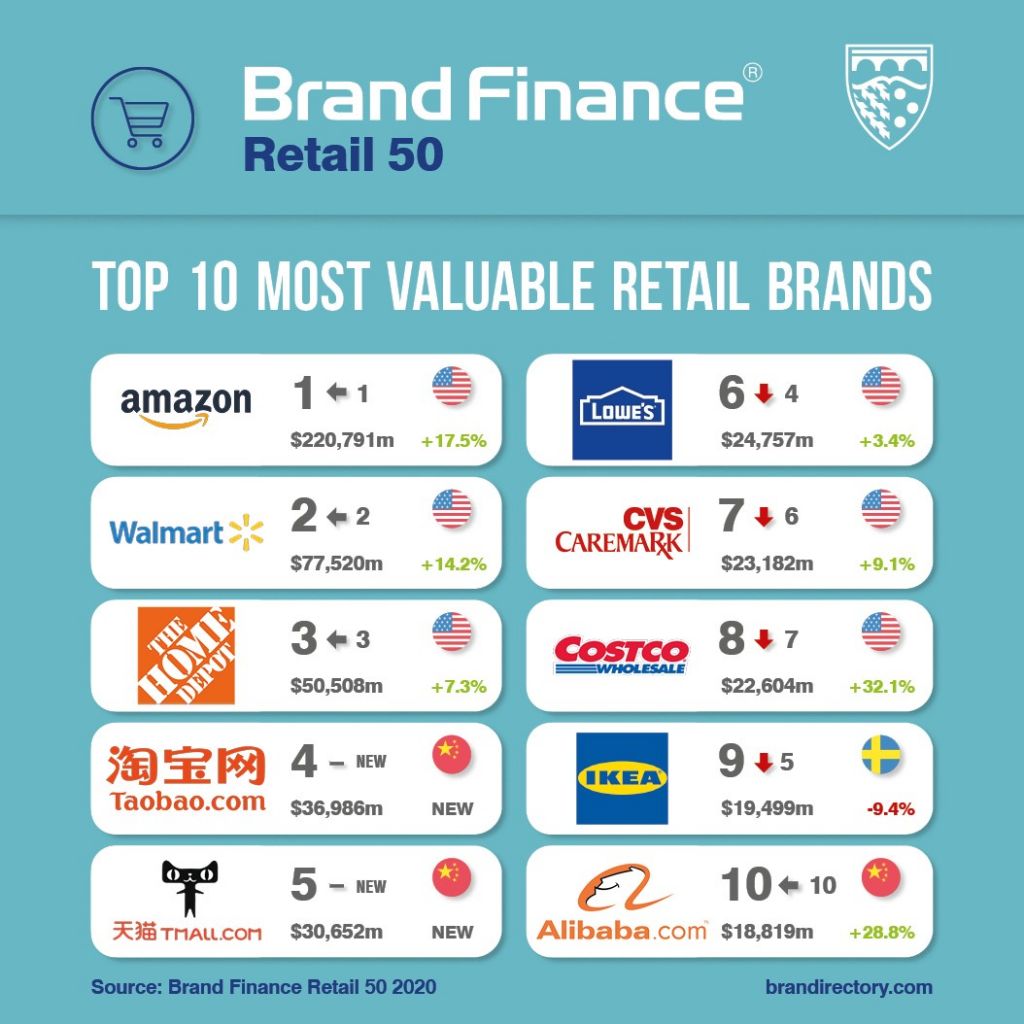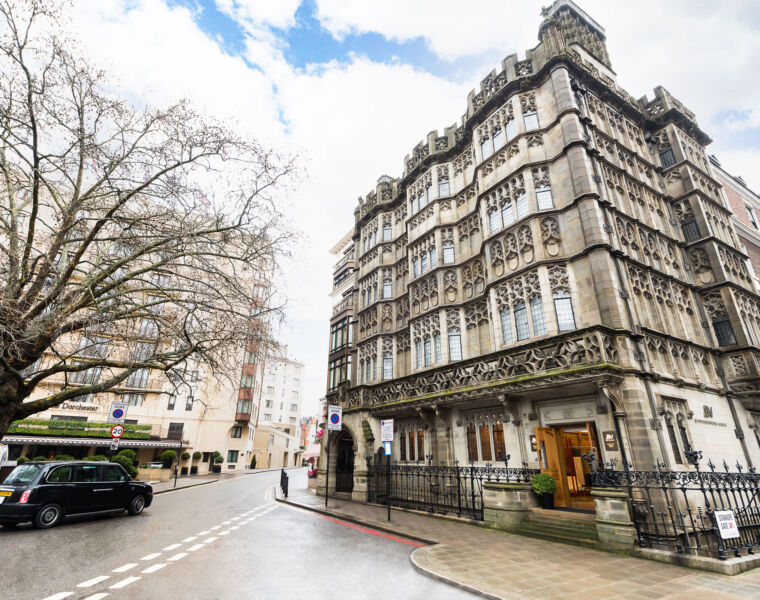
There are mixed fortunes across the retail sector, with Amazon overtaking Japan’s 7-Eleven to become the world’s strongest retail brand, while Home Depot could lose up to US$6 billion worth of its brand value.
Brands in the retail sector are likely to record mixed fortunes as a result of the COVID-19 pandemic, with e-commerce brands predicted to fare the best compared to automotive retailers, which are expected to suffer considerably, according to the latest report by Brand Finance.
The top 50 most valuable retail brands, on average, should see a slight increase in brand value following the pandemic, growing a modest 1% – a result of the majority of the brands in the ranking either being e-commerce brands or dominant, well-known brands, which tend to have strong e-commerce capabilities.
The Brand Finance Retail 50 2020 ranking does not include apparel brands, however, which are predicted to suffer significant damage. Brand Finance has calculated that the apparel sector will be heavily impacted by the COVID-19 pandemic, with brands across the sector potentially losing up to 20% of their brand value.
Richard Haigh, Managing Director of Brand Finance, commented, “The sheer size and diversification of the retail sector mean that brands are inevitably going to be affected differently by COVID-19.
“Brand Finance’s analysis demonstrates that e-commerce brands and dominant retailers in the market could buck the trend and thrive as demand spikes in the online space. At the other end of the scale, automotive retailers could see a 15% drop in brand value as supply chains falter, car use drops and consumer spending habits change.”
Amazon in a league of its own
Amazon remains a cut above the rest in the Brand Finance Retail 50 2020 ranking, breaking the so far unattainable US$200 billion brand value mark, following 18% growth from US$187.9 billion last year.
Amazon’s brand value has now reached US$220.8 billion, substantially ahead of second-placed Walmart, with a brand value of US$77.5 billion. The majority of Amazon’s revenue still comes from its retail division, and despite the growing challenges to the brand – particularly in its international operations – the brand is untouchable in the sector.
While most brands are experiencing or expecting a slump in revenue during the pandemic, Amazon is set for continued growth. As with fellow e-commerce brands, Amazon has been benefitting from the unprecedented surge in demand as consumers turn online following store closures. With over 100,000 workers hired and more in the pipeline, the brand is fighting to meet this demand.
This spike has not come without its challenges, as Amazon’s logistics and supply chain network are being stretched to uncharted levels, and the brand’s illustrious next-day delivery service is being tested, with fulfilment and third-party vendors extending their lead times considerably. First-time users of the platform may not be experiencing the world-leading level of speed that the brand prides itself on, which could jeopardize its long-term reputation.
Richard Haigh added, “Amazon’s sheer dominance in the e-commerce space should stand them in good stead in the coming months as the world tackles the far-reaching repercussions of the COVID-19 pandemic. Brand Finance has calculated that Amazon’s brand value could grow a further US$4 billion thanks to the spike in demand. Nevertheless, the world’s online marketplace must look beyond the coming months to ensure that quality and speed are not compromised should it wish to maintain its exceptional reputation and thus retain new users.”
In addition to measuring overall brand value, Brand Finance also evaluates the relative strength of brands based on factors such as marketing investment, familiarity, loyalty, staff satisfaction, and corporate reputation. Alongside revenue forecasts, brand strength is a crucial driver of brand value. According to these criteria, Amazon is the world’s strongest retail brand, with a Brand Strength Index (BSI) score of 89.1 out of 100 and a corresponding AAA brand strength rating.
Despite Amazon claiming this position for the first time, the brand has recently been handling less than favourable attention for its warehouse conditions, with concerns being raised further for safety during the current COVID-19 pandemic. With multiple employee strikes, the brand’s response will be crucial should Amazon wish to maintain staff satisfaction and, thus, a high BSI score.

Walmart on the rise
In the traditional retail space, Walmart has seen its brand value resurge, jumping 14% to US$77.5 billion. As well as committing to its expansion programme in key markets, Walmart has focused on an innovative digital proposition through a partnership with Microsoft and with the launch of Alphabot – robots that pick and pack online grocery orders at high speeds.
Walmart – along with fellow mass merchant stores and supermarkets – is likely to see a boost to brand value following the COVID-19 pandemic as demand reaches an all-time high and strong storage and supply capabilities can be leveraged.
Supermarkets surge
Discount supermarket chain rivals Lidl (US$12.4 billion) and Aldi (US$14.3 billion) are the fastest-growing retail brands in the ranking, growing 40% and 37%, respectively. Lidl and Aldi have reshaped the supermarket landscape by winning market share from their long-established high-street counterparts.
Initially competing on price leadership, both chains have gradually earned their customers’ trust and loyalty. With almost identical propositions, however, the brands will need to differentiate themselves in order to continue to successfully widen their footprint globally.
In contrast, British supermarket chain Sainsbury’s is this year’s fastest-falling brand after dropping 27% to US$4.2 billion. Two further British supermarkets feature in the ranking, Tesco (down 3% to US$11.0 billion) and Asda (up 14% to US$6.3 billion), claiming 16th and 28th position, respectively.
In Spain – one of the worst-hit nations from COVID-19 – Mercadona is one of the top 5 fastest-growing brands, up 30% and simultaneously jumping from 48th to 41st position in the ranking.
Richard commented: “Supermarkets are one of the few winners to come out of the COVID-19 pandemic, with brands seeing Christmas levels of demand, resulting in hiring sprees for thousands of temporary workers – Tesco alone has hired 20,000 new workers in the UK. It is likely that many of them will rebound and post positive brand value growth over the course of 2020, while brands in other retail segments are struggling.”
Hardship ahead for home product stores
Despite being the world’s third most valuable retail brand and recording a solid 7% increase in brand value to US$50.5 billion, Brand Finance’s COVID-19 impact analysis suggests that home furnishing and improvement stores such as Home Depot are likely to lose the most brand value, dropping up to US$6 billion.
Although the brand has cited increased demand for urgent home repair products, this demand is unlikely to offset the decline in big-ticket item purchases, as well as other construction products.
The story is similarly as bleak for fellow home product stores in the ranking – Lowe’s (up 3% to US$24.8 billion), Ikea (down 9% to US$19.5 billion) and Leroy Merlin (up 21% to US$4.7 billion) – which all stand to lose 12% of their brand values. These brand’s lack of strong online presence means they will struggle to maintain sales revenue as they negotiate reduced store hours and closures.
As with other brands globally, the level of damage to these stores will depend on how long the pandemic engulfs their markets.
View the full Brand Finance Retail 50 2020 report here.
![]()




You must be logged in to post a comment.